A Tale of Two Rivers

![]() The Canadian shipping company of Saguenay Terminals of Montreal operated a big fleet of owned and chartered general cargo ships, ore/oil ships, and geared dry bulkers for over four decades for the aluminium industry of Alcan. They were mainly employed on a route linking two rivers four thousand miles apart, the beautiful Saguenay river flowing as the biggest tributary into the St. Lawrence estuary, and the hot and humid Demerara river in British Guiana, now Guyana. These ships also operated on other routes from the St. Lawrence to Guinea in West Africa, also to Kitimat (BC) from Jamaica, to Alcan plants in Norway and the U.K. The shallow depth of the Demerara river needed smaller ore/oil ships to load shuttle cargoes of bauxite for transport to the Chaguaramas plant near Port of Spain in Trinidad, which converted the bauxite into alumina white powder, and then back load with cargoes of bunker ‘C’ fuel oil from South Trinidad, San Fernando or Caripito on the San Juan river in Venezuela.
The Canadian shipping company of Saguenay Terminals of Montreal operated a big fleet of owned and chartered general cargo ships, ore/oil ships, and geared dry bulkers for over four decades for the aluminium industry of Alcan. They were mainly employed on a route linking two rivers four thousand miles apart, the beautiful Saguenay river flowing as the biggest tributary into the St. Lawrence estuary, and the hot and humid Demerara river in British Guiana, now Guyana. These ships also operated on other routes from the St. Lawrence to Guinea in West Africa, also to Kitimat (BC) from Jamaica, to Alcan plants in Norway and the U.K. The shallow depth of the Demerara river needed smaller ore/oil ships to load shuttle cargoes of bauxite for transport to the Chaguaramas plant near Port of Spain in Trinidad, which converted the bauxite into alumina white powder, and then back load with cargoes of bunker ‘C’ fuel oil from South Trinidad, San Fernando or Caripito on the San Juan river in Venezuela.
The Saguenay River
The Saguenay river flows through a beautiful natural fjord into the St. Lawrence, and was formed from a retreating glacier splitting a deep crack in the Earth’s crust during the last Ice Age, over ten thousand years ago. The inky waters run for 95 miles up to 985 feet deep beneath cliffs that average three hundred feet in height. Running from Lac St. Jean to the St. Lawrence, the Saguenay is known for its lush forests and wildlife that abound in the lower reaches. A Canadian Federal Marine Park occupies the southern half of the river, with whales and dolphins to be seen from riverboats. A beautiful view of most of the length of the sunken fjord is available on the western shore at Cape Trinity, a cliff that rises 1,050 feet over the channel, with a statue of the Virgin Mary overlooking the scenery from the lowest ledge.
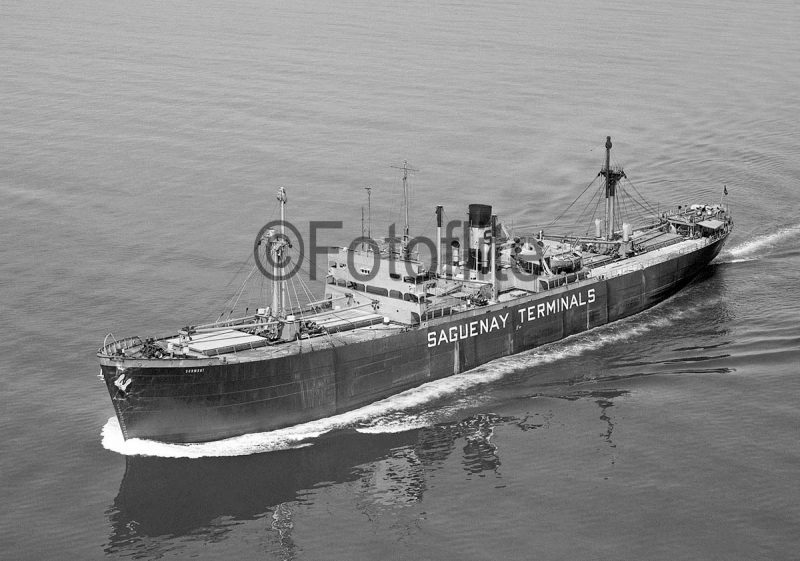
However, the sunken Saguenay river underwent a dramatic transformation prior to and after World War II, as the exploitation of the Saguenay for hydro-electric power led to the construction of the largest aluminium plant in the world at Arvida, near Chicoutimi. The industrial town of Arvida was founded in 1927 and named after Arthur Vining Davis, President of the Alcoa company, later Alcan. The first aluminium smelter was constructed here, and the town was developed as a company town for 14,000 inhabitants, with schools, four Catholic parishes, and priests of other denominations, with the town completed in 135 days, and was later in post-war years renamed Jonquiere. Nearby Chicoutimi is known as the ‘Queen of the North’ with its colourful timber houses and majestic scenery. Port Alfred was founded on 22nd April 1918 by a French Canadian industrialist and annexed the village of Grande Baie in 1953, with the Alcan discharging quay at Port Alfred now massively expanded to berth three large bulk carriers simultaneously at the Duncan and Powell Wharves. Chicoutimi has a summer cruising season for Saguenay riverboats during the four months from June to September, and also has a cruise terminal where the biggest cruise liners in the world call in, including the QM2 of Cunard Line. The boroughs of Chicoutimi, Port Alfred, Jonquiere and La Baie are today all part of the city of Saguenay at the head of navigation on the Saguenay river.
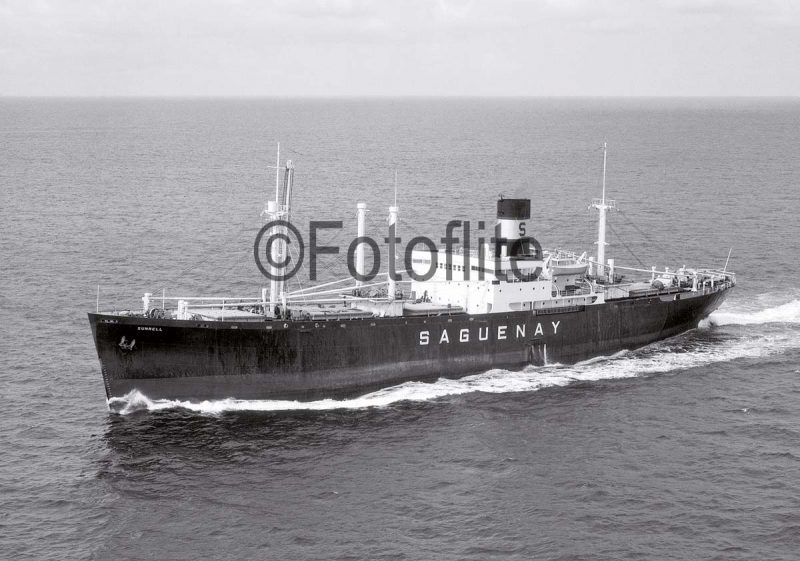
The Isle Maligne Power Station came on stream during 1925 as the largest in the world, and two years later the first ingots of aluminium were produced at the Arvida plant. In 1932, Chute-a-Caron Power Station near Kenogami came on stream, and the nearby Shipshaw Power Station came on stream during 1940 to provide the huge amounts of electricity needed to convert bauxite into alumina, and then alumina into aluminium ingots by electrolysis. The smelter expanded during World War II and further large hydro-electric schemes were completed to become the largest aluminium producing plant in the world. Its importance to the Allied cause was show by the large number of anti-aircraft gun batteries surrounding the plant to prevent any Axis attempt to bomb it. The plant employed 7,500 men throughout the 1950s and 1960s, and was due to close in 2005, but was saved by Rio Tinto Alcan as an important commercial aluminium smelter.
The conjunction of the Saguenay natural river resources had begun the development of the aluminium industry of Alcan, with raw materials imported to the plant by Saguenay Terminals ships and the finished aluminium ingots exported by these ships. The Saguenay river is open to navigation for most of the year, but ice forms in the upper reaches for up to four months of the year, with snow lying around the Jonquiere aluminium production plant as the temperatures in January can fall as low as minus twenty Centigrade. Summer rainfall characterises the Saguenay with up to 4.5 inches of rain common during each of the months of May, June, July, August and September.
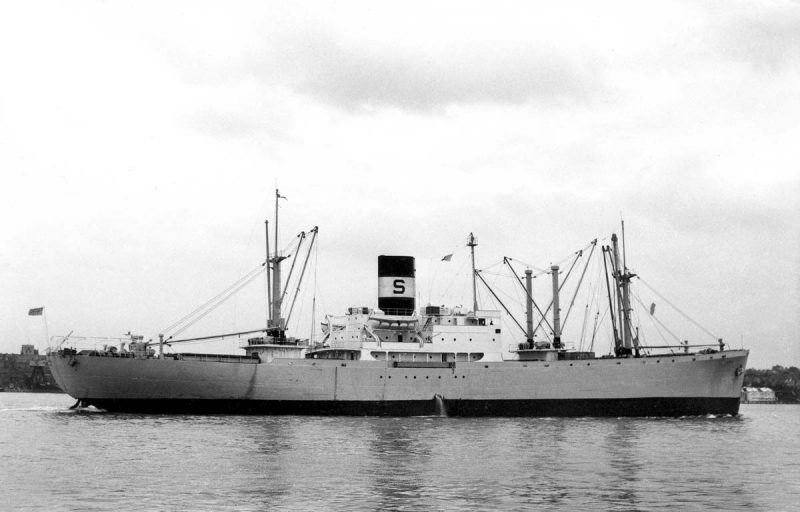
The Demerara River
The Demerara river is located in the former British Guiana, and now the eastern part of Guyana, and it rises in the central rainforests of the country and flows north for 346 kilometres until it reaches the Atlantic Ocean. The town and seaport of Georgetown is situated on the east bank of the river mouth, and the width and depth of the river only allows vessels up to 8,000 dwt to load part cargoes of bauxite at Mackenzie, part of Linden town, the second largest town in Guyana and capital of the Upper Demerara Berbice region. Mackenzie is a bauxite mining town with many mines up to one hundred metres in depth. Commercial bauxite mining started here in 1916 by the Demerara Bauxite Co. Ltd. (DEMBA), a subsidiary of Alcoa, later Alcan.
The port of Mackenzie is named after the American geologist of Scottish descent, George Bain Mackenzie, who first explored the area for bauxite in 1913. He built several 45 tonne wooden barges in 1916, with the bauxite mining manually with picks and shovels to be transported on mule carts to the barges, which were then towed down the river to deep sea ships moored off Georgetown harbour. Chartered vessels were used at first, but the name of Saguenay Terminals first came into use in 1937 with the delivery of three ships of 9,050 dwt by the North Sands yard of Joseph Lowes Thompson at Sunderland.
First Saguenay Terminals Fleet
This trio of triple expansion steam powered vessels was delivered in February, June and August of 1937 at Sunderland as Newton Moore, Sire and Corabella for the single ship companies of the Bespian Steamship Co. Ltd., Sire Steamship Co. Ltd. and the Tenax Steamship Co. Ltd., all under the management of Muir, Young Ltd. The trio had overall lengths of 425.3 feet, with a Bridge Deck of length 122 feet, fo’c’stle of length 32 feet, and poop of length 35 feet, and their gross tonnage was measured at 5,675, with their triple expansion steam engines installed nearby by George Clark & Co. Ltd. Unfortunately, only Newton Moore survived World War II, being renamed Peribonka in 1940 and Sunwalt in 1948. Corabella was torpedoed and sunk on 30th April 1943 in position 7°14’ North, 13°48’ West while on a voyage from Takoradi for Freetown and the U.K. with a full cargo of manganese ore with the loss of nine members of her 48 strong crew, while Sire was torpedoed and sunk earlier on 31st May 1941 in position 8°50′ North, 15°30′ West while on a voyage in ballast to Pepel to load iron ore, three crew being unfortunately lost.
The Doxford built Turret Cape of 1,827 grt was completed in 1895 for the Turret Steam Shipping Co. Ltd. (Capt. Petersen, manager). After a long sea-going career, she was purchased by Saguenay Terminals in March 1941 and rebuilt as a diesel powered ship with a new weather deck by the Davie Shipbuilding and Repairing yard at Lauzon on the St. Lawrence and registered at Port Alfred on the Saguenay. She survived the war and was renamed Sun Chief in 1947 and carried bauxite for a year. She was then sold to Capt. Robert Scott Misener of Port Colborne, who had her refitted in his home yard for Great Lakes service. She was renamed Walter Inkster and traded along all of the Great Lakes for nine further years until she was dismantled in a dry-dock at Port Dalhousie in 1959, after a long career of 64 years.
The United States War Shipping Administration allocated many vessels to Saguenay Terminals during the war, including two former U.S. Navy colliers, Nereus and Proteus, and both lost to enemy submarines. This pair of engines aft vessels had six holds and derricks on seven goalpost masts and were of 11,800 dwt when completed in July and September 1913 by the Newport News yard on dimensions of length overall of 522.0 feet, moulded beam of 62.0 feet and loaded draft of 27.7 feet. They were stricken from the U.S. Navy List at the end of 1940 and purchased by Saguenay Terminals in March, 1941. Unfortunately, both were soon lost to German submarines, with Proteus sailing from St. Thomas in the Virgin Islands for Portland (Maine) with bauxite on 23rd November 1941, followed by her sister Nereus sailing from the same port for the same destination with the same type of cargo on 10th December 1941.
The American tonnage continued to be provided until 1946, when seven war built ‘Fort’ and ‘Park’ standard ships of 10,000 dwt were purchased and renamed a year later as Sunavis (ex Eastwood Park), Sunjewel (ex Highland Park), Sunmont (ex Simcoe Park), Sunray (ex Grafton Park), Sunrell (ex Fort Columbia), Sunvalley (ex Fort Panmure) and Sunwhit (ex Wellington Park). Three ‘Scandinavian’ type of ‘Park’ vessels of 4,624 dwt for use on the shuttle trade from Mackenzie to Chaguaramas on Trinidad were also purchased and renamed Sundale (ex Bloomfield Park), Sundial (ex Wentworth Park), and Sunprince (ex Shakespeare Park). Saguenay Terminals first fleet had bright green hulls and lifeboats, with bulwarks, superstructure, masts, kingposts and derricks painted in an aluminium colour.
Triangular Trade Route
Thus in 1950, Saguenay Terminals had a fleet of eleven owned vessels and a much bigger chartered fleet of eighty vessels, this chartered fleet growing to more than ninety ships by 1959. They were needed for a new triangular trade when the Saguenay river was blocked by ice for four months of the year of an eastward trade from ice free ports such as Halifax (NS) to U.K. and Continental ports, and then sailing south west to Caribbean ports with manufactured goods, and finally northbound from Georgetown, Mackenzie and Chauguaramas to eastern seaboard Canadian ports. A trade route also ran from the Eastern seaboard of Canada via the Panama Canal to West Coast ports of Canada and the United States of America. The North Atlantic trade route operated as an independent, non Conference line from its inauguration on 2nd January 1954, especially for the needs of Canadian shippers whose costs had escalated to the point that they could not compete in European markets due to the higher transport costs of the Conference lines. Thus, Saguenay Terminals began to serve the needs of its parent company of Alcan and of the export needs of Canadian shippers on long term contracts of up to two years at fixed freight rates.
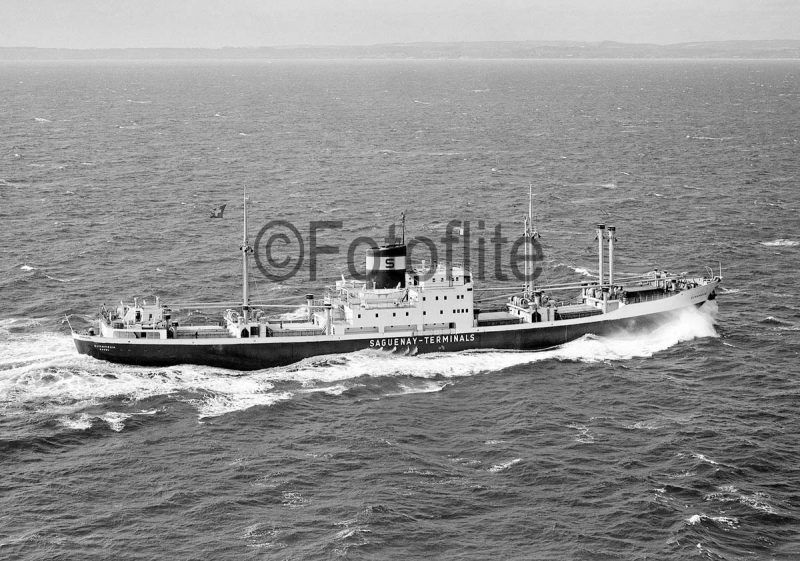
The second leg of the triangular route was a direct fast service from British and North Continental ports to Barbados, which had a bauxite loading terminal, Trinidad and Demerara, calling at the Dominican Republic, Haiti, southern ports of Cuba, Antigua, Dominica, Montserrat, Nevis, St. Kitts, St. Lucia, Grenada, St. Vincent, Tobago and at Caripito in Venezuela if there was sufficient cargo inducement or transhipment. The U.K. loading agents were Joseph Constantine & Sons Ltd. in London, and the service was run jointly with the Caribbean service of T. & J. Harrison Ltd. The London loading berths were in the West India Docks and later in the Royal Albert Dock, and the ship’s agents at the loading ports were as follows:-
- LONDON Stewart & Esplen Ltd.
- LIVERPOOL Bahr, Behrend & Co.
- CARDIFF Strick, Gorchs & Co.
- GLASGOW Whimster & Co.
- MIDDLESBROUGH Constantine & Sons
- NEWCASTLE Brantford International
- ANTWERP W.H. Newman & Son
- ROTTERDAM Meyer & Co.
- HAMBURG Robert M. Sloman
- COPENHAGEN K. Hansen
- BREMEN Herman Dauelsberg & Sohne
Saguenay Terminals operated two distinct branches, with the main Shipping Department in Montreal, and the Port Alfred Department on the Saguenay river looking after the storage of alumina and bauxite, stevedoring and harbour facilities, with two of the Alcan owned tugs used to berth the fleet being Grande Baie 194grt/1972 and Alexis Simard 286grt/1980. F. Leslie Parsons was President and General Manager of Saguenay Terminals and masterminded the whole operation and trades, W. Baatz and J. A. Watson were Vice Presidents, and there were eight other directors or managers. In winter, vessels used Halifax (NS) as the ice free port, berthing at Piers 9 and 36, now within the Halterm Container Terminal area.
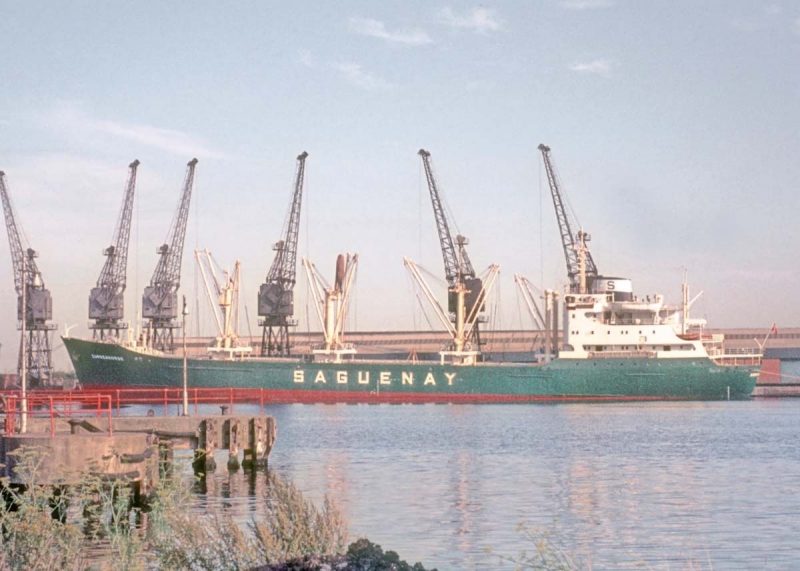
A large number of engines ‘midships general cargo vessels were chartered during the 1950s and 1960s by Saguenay Terminals for the company trades including seven C1-A standard war built ships renamed Sunrose, Sunbeam, Sunfalcon, Sunhill, Sunprincess, Sunflower and Sunland, and the former ‘MAC’ escort carrier Empire MacCallum built in 1944 and renamed as Sunrover between 1951 and 1957 after conversion to a general cargo ship. Sunprincess was lost by collision with Geologist of T. & J. Harrison Ltd. on 13th July 1955 in a position 7.1 miles off Pointe a Diable in Trinidad. Short time chartered tonnage was also sourced from British, Canadian, Swiss, Yugoslav, German, Norwegian and Greek fleets, with their ships usually not renamed with ‘Sun’ prefixes due to the shortness of their charters.
The chartered engines ‘midships list included Sunadele 4,975grt/1952, Sunamelia 4,998grt/1952, Suncliff 7,864grt/1958, Sunda 5,699grt/1953, Sundale 6,044grt/1964, Sundove 3,890grt/1960, Sunetna 8,708grt/1958, Sungate 8,370grt/1958, Sun Gleam 3,807grt/1945, Sungran 8,587grt/1955, Suninger 7,547grt/1956, Sunjarv 7,155grt/1944 (ex Sunray), Sun Karen 8,141grt/1945 (ex Colorado Springs Victory), Sunkirk 7,157grt/1944, Sunlight 7,201grt/1944, Sunlong 7,176grt/1944, Sunmar 3,775grt/1959, Sunmont 6,650grt/1953, Sunmoss 6,173grt/1956, Sunoak 8,584grt/1956, Sunpalermo 8,677grt/1957, Sunpolyna 8,985grt/1956, Sunpolynesia 8,971grt/1956, Sunrana 8,805grt/1958, Sunrip 9,541grt/1954, Sunrise 6,155grt/1956, Sunset 7,210grt/1944, Sunvictor 9,266grt/1957 and Sunvalley 5,136grt/1949.
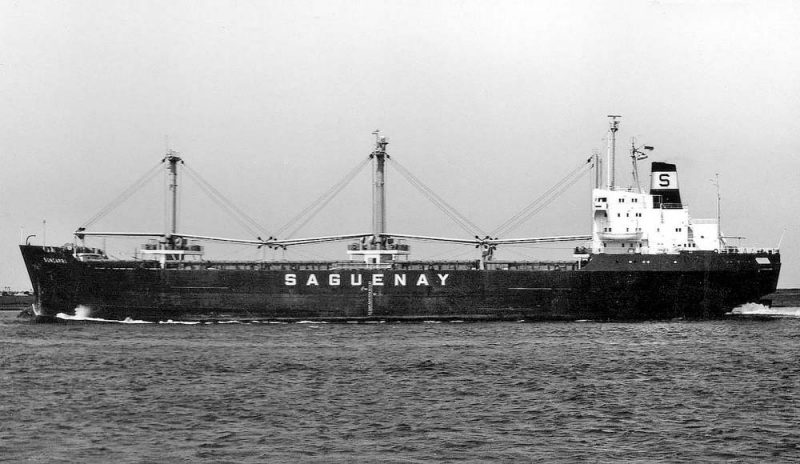
Sunrip of 12,825 dwt was launched from the Lauzon yard of Davie Shipbuilders Inc. on the St. Lawrence in 1954, and was given three masts and a dozen derricks as well as a unique design of hatches that enabled her to quickly change from carrying bauxite or alumina to the triangular trade of general cargo. She had her unpainted aluminium superstructure block weighing 140 tonnes lifted onboard in one section at the Canadian shipyard. She was powered by twin steam turbines double reduction geared to a single shaft and manufactured by John Inglis and Co. Ltd. of Toronto.
A large number of engines aft bulk carriers were also chartered during the 1950s and 1960s by Saguenay Terminals including Sunbreeze of 11,650 dwt, Suncorona of 13,076 dwt, Sundale of 8,350 dwt (ex Ima Sam built in 1964 and chartered for six years until 1970), Sundora of 16,178 dwt, Sunek of 16,610 dwt, Sungeira of 15,900 dwt, Sunheim of 15,250 dwt, Sunjarv (2) of 15,050 dwt and chartered from ‘Paddy’ Henderson of Glasgow between 1965 and 1970, Sunleaf of 13,615 dwt, Sunmalka of 22,600 dwt, Sunmaple of 18,200 dwt, Sunpolycrown of 18,490 dwt, Sunpolytrader of 18,200 dwt, Sunrhea of 16,620 dwt and built by Davie Shipbuilders at Lauzon on the St. Lawrence in 1958, Sunray of 20,075 dwt, Sunriver of 12,800 dwt, Sunsea of 20,509 dwt, Sunseahorse of 6,030 dwt, Sunvard of 13,615 dwt, as well as three German ‘Liberty’ ships named Suncapri (15,381 dwt/1969), Sundirk (15,079 dwt/1968) and Sunsaxonia (14,734 dwt/1968).

Sunek was completed in December 1958 by the Uraga Dockyard at Yokosuka, and had an unpainted aluminium superstructure block, with the hatch covers in the ‘tween decks dispensed with, and she was powered by twin steam turbines double reduction geared to a single shaft. She was in collision in a blinding snowstorm off Ile d’Orleans fourteen miles below Quebec on 16th November 1965 with the Laker Lawrencecliffe Hall. The Laker rolled over and sank in 35 feet of water, but was later refloated and towed to the Davie Shipyard at Lauzon for repairs and a refit before re-entering service.
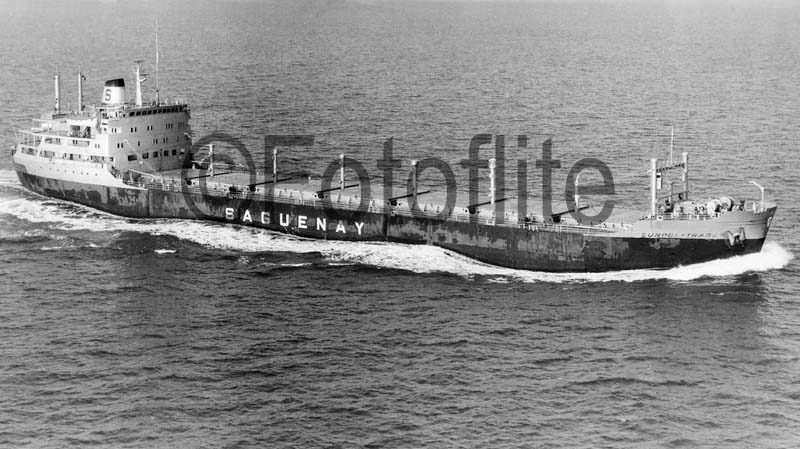
Saguenay Terminals Ore/Oil Fleet
Sunbrayton was the first of a special type of Saguenay Terminals shuttle ore/oil vessel for the shallow draft passage up the Demerara river to Mackenzie to load bauxite, having backloaded with bunker ‘C’ fuel oil from Trinidad or Venezuela. She was delivered in early 1954 and named after Sherman Brayton, who had been lost during World War II on the Nereus. She was completed by the Burntisland yard as an engines aft ship of 7,850 dwt with her navigating bridge well forward and a loaded draft of twenty feet. She had four main hatches and a very small hatch forward of her navigating bridge, with two goalpost masts, one forward of her bridge, and the other forward of the aft accommodation. She undertook her speed and power trials in the Firth of Forth, and then sailed for Chaguaramas, which lay 425 miles from her shuttle port of Mackenzie on the Demerara river.
A draft limitation over the Georgetown bar at the entrance to the Demerara river prevented the deeper draft Saguenay Terminals ships to loading more than 45% of their capacity. Sister ore/oil carriers Sunhenderson of 9,200 dwt from the H. C. Stulcken yard at Hamburg in 1957, and Sunwalker of 8,959 dwt from the Uraga Dock Company in Japan in the same year, had dimensions of length 450.0 feet, moulded beam of 63.5 feet, and loaded draft of 20.0 feet, while Sunbrayton was eight feet shorter in length and three feet shorter in beam than Sunhenderson and Sunwalker. The trio were powered by triple expansion steam engines by Rankin and Blackmore for Sunbrayton and Sunhenderson, and by the Uraga Dock Company for Sunwalker.
Sunhenderson loaded the first cargo of refined alumina from Mackenzie and sailed on 28th March 1961 after the new DEMBA plant, built at a cost of $65 million, was declared open by Dr. Cheddie Jagan, Minister of Trade and Industry for British Guiana. Previously, the raw bauxite was refined into alumina at the Chaguaramas plant on Trinidad, but this trade also continued. This trio had replaced the war built trio of ‘Park’ ships of 4,624 dwt that had previously operated the shuttle service. The shuttle ships had Guyanese deck crews, and later former Demerara river pilots as deck officers, as the Saguenay Terminals policy was always to use Caribbean seafarers if possible.
Saguenay Terminals Passenger Service
A regular and frequent cargo and passenger service operated from Canadian ports to the Caribbean ports of San Juan (Puerto Rico), Dominican Republic, Haiti, Guadeloupe, Martinique, Cuba, British Honduras, Guatemala, Costa Rica, Panama, Colombia, Venezuela and Curacao. Many of the huge fleet of chartered cargo-liners had accommodation for a dozen passengers, the maximum allowed to be carried without a doctor being onboard. The triangular route of the company also allowed a small number of passengers to be carried from Canada across the Atlantic to British and North Continental ports. The informal travel offered by cargo-liners was much preferred by many businessmen and travellers, who preferred a quiet mode of sea travel compared to the constant activity on a big passenger liner. Surprisingly spacious and luxurious accommodation was provided in these cargo-liners, as many of the staterooms had been designed as luxury travel for the shipowner. A Passenger Department was operated by Saguenay Terminals Ltd. at their Head Office of the Terminal Centre Building, 1060 University Street in Montreal for passengers to choose their ship and time of travel from the vast number of over seventy chartered international cargo-liners.
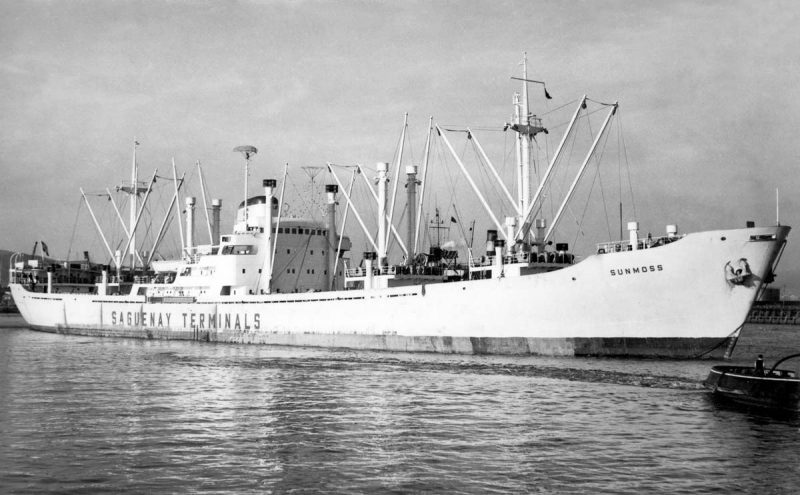
Five new vessels were completed in 1956 for long term charter to Saguenay Terminals in the five hatch engines ‘midships Suninger of 10,600 dwt, Sunmoss of 12,854 dwt, Sunoak of 12,620 dwt, and Sunpolyna of 13,050 dwt, and the engines aft bulker Sunbreeze of 11,650 dwt. Their hull dimensions were all very similar, in the range of length 460 to 480 feet, moulded beam of 58 to 62 feet, depth moulded to their shelter deck of 40 feet, and loaded draft of around 28 feet. Their Norwegian, Swedish and German builders fitted them with diesel engines ranging from 5,400 to 6,100 bhp at 112 rpm to give service speeds of fifteen knots, and a dozen derricks ranging from 15, 10 to 5 tonnes capacity on bipod masts or posts. Sunbreeze was a self trimming bulker with one tier of ‘tween decks, and her bridge well forward, with four main holds, and one deep tank with a smaller hold above it forward of the bridge.
Saguenay Terminals deep draft vessels were able to carry Alcan aluminium products and ingots into the Great Lakes from the Saguenay river, and then load grain outwards for all of the major ports of the world, after the opening of the St. Lawrence Seaway in April 1959. The Royal Yacht Britannia with H. M. The Queen and President Eisenhower on her bridge sailed gently through the symbolic portals into St. Lambert Lock at noon on 27th June 1959 to officially open the Seaway. In her speech, H. M. The Queen referred to the gigantic project which cost £360 million to build over five years as ‘one of the outstanding engineering achievements of modern times’. The channel has a minimum draft of 27 feet, enabling deep-sea shipping to enter the Great Lakes. After disembarking from the Royal Yacht, H. M. The Queen and President Eisenhower stood on a large white painted dais to watch the busy traffic flowing along the Seaway.
In 1969, the bareboat chartered ore/oil carrier Sunhenderson was sold to Ore Cargo Line of Monrovia and renamed John Crosby, and continued trading in the Caribbean after being renamed Jesterole in 1973 by Coast Navigation Inc. of Monrovia, but she passed through the Panama Canal in early 1974, and sailed from Honolulu on 4th April 1974 for breaking up in Pusan in Korea. The sister bareboat chartered ore/oil carriers, Sunbrayton and Sunwalker, continued on the Mackenzie to Chaguaramas run, back loading with oil from Venezuela. There were still over thirty chartered ships in the Saguenay Terminals fleet in the early 1970s including the bulker Sunray of 20,075 dwt, which could also carry 92 TEU of containers on her deck and was fitted with two container handling cranes. She operated on a weekly mixed cargo and container service from Eastern Canadian ports to ports in the Caribbean, along with Britta Kruger of 7,047 dwt and carrying 202 TEU of containers at a service speed of fifteen knots, and again was equipped with two container handling cranes.
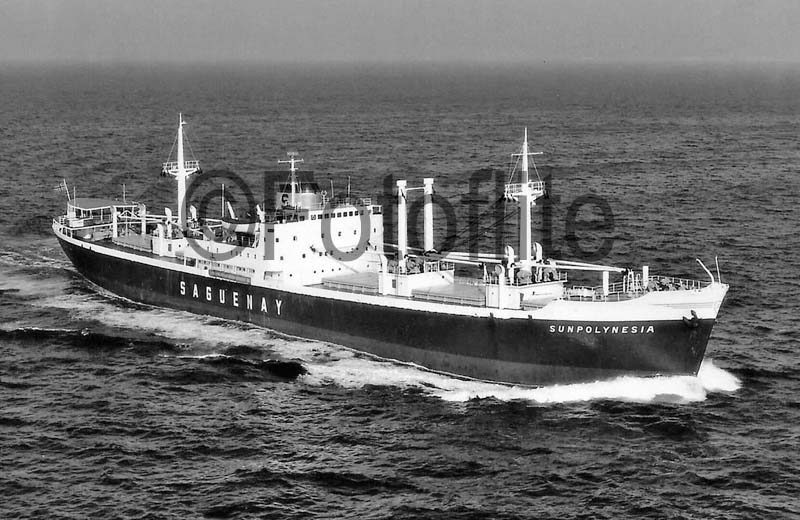
Chartered cargo ships in the early 1970s included four other German ‘Liberty’ types, Sunbaden (15,381 dwt/1970), Sunfrancis (15,138 dwt/1970), Sunlina (15,330 dwt/1971) and Sunvreeland (15,138 dwt/1970) and owned by Fisser and Doornum of Hamburg. The bulkers Sunclipper of 18,125 dwt and Sunrana of 19,950 dwt were on long term charter from Hansen-Tangen of Kristiansand in Norway, while the bulker Sunima of 19,715 dwt was on long term charter from Schroder of Germany and Sunprince of 22,600 dwt was on long term charter from Sicula Sarda of Italy. The President of Saguenay Terminals Ltd. at this time was John L. Eyre, Vice President C. Sabinsky, Vice President and General Manager R. Scott, and the Board of Directors was completed by another eight directors.
Saguenay Terminals Finale
The large number of chartered vessels had fallen by 1979 to only twenty vessels, many of which were on short charters of six months or less, and thus were not renamed with ‘Sun’ prefixes. The bareboat chartered ore/oil vessels and long term chartered bulkers in 1979, including four new ‘Fortune’ type bulkers of 17,200 dwt with five hatches and three unusual cranes chartered from Anangel of Greece were trading as follows:-
- Sunbrayton: Mackenzie (Guyana) to Chaguaramas (Trinidad)
- Sunwalker: Mackenzie (Guyana) to Chaguaramas (Trinidad)
- Sunray: Caribbean ports to Eastern Seaboard Canada
- Sunarawak: Demerara to Hamburg or Rotterdam
- Suncaribe: Demerara to Hamburg or Rotterdam
- Sunguajira: Caribbean ports e.g. Cartagena (Colombia) to European ports
- Sunmaria: Caribbean ports to Eastern Seaboard Canada
- Sunriver: Caribbean ports to Eastern Seaboard Canada
- Sunwave: Caribbean ports to Eastern Seaboard Canada
- Sunway: Caribbean ports to Eastern Seaboard Canada
Sunwalker was sold in 1980 to Guybulk Shipping Ltd., the State owned Guyana fleet, and renamed Aroaima, and Sunbrayton was sold to Bauxite Bulk Carriers Inc. of Monrovia and renamed Topira in the same year, and both continued in their lifelong trades of shuttling between Mackenzie on the Demerara river to Chaguaramas on Trinidad. The part container bulker Sunray (ex Tonto) was equipped with container handling derricks on three masts and two pedestal cranes, and was sold to PH Ships of Panama and renamed Gungnir V, while the Anangel quartet kept on trading for another two years until their charters ran out. The Alcan subsidiaries of Saguenay Terminals and Saguenay Shipping were then phased out. However, big cargoes of bauxite and alumina continued to arrive in a great variety of voyage chartered bulkers at Port Alfred on the Saguenay, and at Blyth in Northumberland for the two Alcan British smelters at Lynemouth in Northumberland and Fort William in Scotland, and at Norwegian ports for the several Alcan smelters located in fjords.
Alcan (U.K.) Ltd.
The Blyth Alcan terminal handled well over one thousand chartered bulkers in the thirty eight year period between 1974 and 2012, with the imported alumina transported by rail to the Lynemouth and Fort William smelters. Greek, British and internationally owned bulk carriers predominated, but former chartered Saguenay Terminals vessels did arrive regularly e.g. Sunpolytrader arrived at Blyth between 1974 and 1976 as Polytrader of 18,200 dwt. Hogarth of Glasgow chartered Baron Dunmore to Saguenay Terminals in 1968, and the sister bulkers Baron Belhaven of 23,714 dwt and Cape Race of 23,684 dwt, built in 1971 for Scottish Ship Management, ran with alumina from Port Esquivel in Jamaica for many years from 1974 on charter to Alcan (Bermuda) and not Saguenay Terminals. They were both sold to Alcan in 1979, and then ran alongside Greek bulkers e.g. Evimeria of 22,630 dwt, Polydefkis of 19,205 dwt, Adonis of 15,679 dwt, and Almazal of 16,875 dwt arriving at Blyth from Jamaica and Australia.
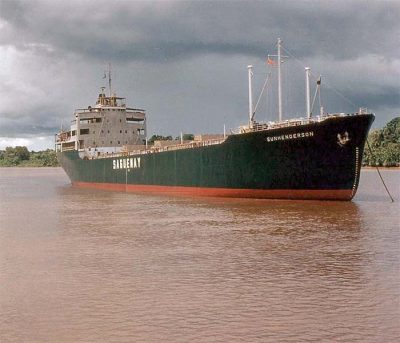
The fleet of Stephenson Clarke Ltd. (SCS-Bulk) with Sea Amethyst of 11,900 dwt and their four ‘D’ class bulkers Dallington (12,140 dwt/1975), Donnington (11,999 dwt/1975), Durrington (11,990 dwt/1981) and Storrington (11,990 dwt/1982), then supplied Blyth with transhipped alumina from Aughinish on the Shannon until their contract was taken over in 2001 by Arklow Shipping Ltd. of Ireland with their ‘D’ and ‘W’ class bulkers of 12,000 dwt e.g. Arklow Dawn, Arklow Day, Arklow Dusk, Arklow Wind and Arklow Wave who then predominated during the final decade of operation at Blyth. Aughinish Island on the south bank of the Shannon near Foynes has its own alumina plant refining bauxite and producing aluminium.
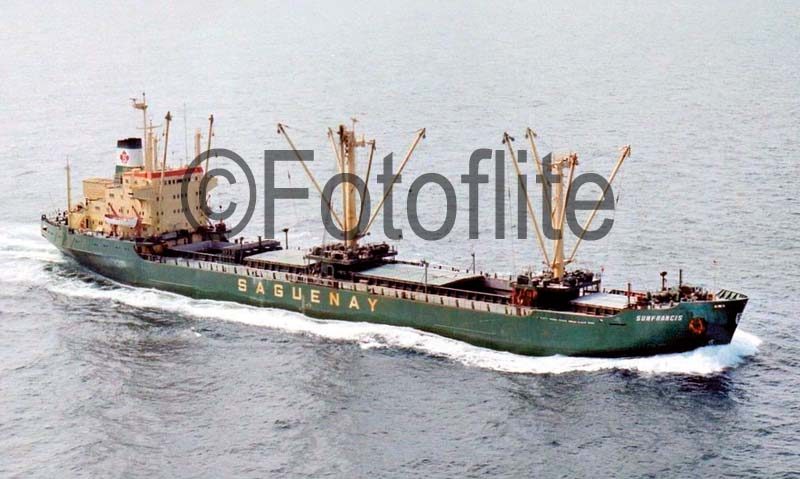
The Lynemouth smelter of Alcan opened in 1974 at a cost of £54 million with eight ring burners and eight tall chimneys, and ceased production in March 2012. Alcan commissioned the nearby Lynemouth Power Station of 420 megawatt capacity in 1972 to supply huge amounts of coal produced electricity needed during the electrolysis process. A change of fortune for Blyth Harbour Commission occurred in 1974 when their deep water port four miles south of the smelter was selected as an import terminal on the north bank of the harbour to transfer over half a million tonnes of alumina by rail to Lynemouth per year. The import terminal had a deep water quay with an alongside depth of 10.4 metres, three brown painted large silos, and a blue and yellow discharging crane with a long extended boom. Labour was plentiful for the new smelter as the Northumberland coal field was closing down at an alarming rate, with the nearby Ellington Colliery the last to close in 2005.
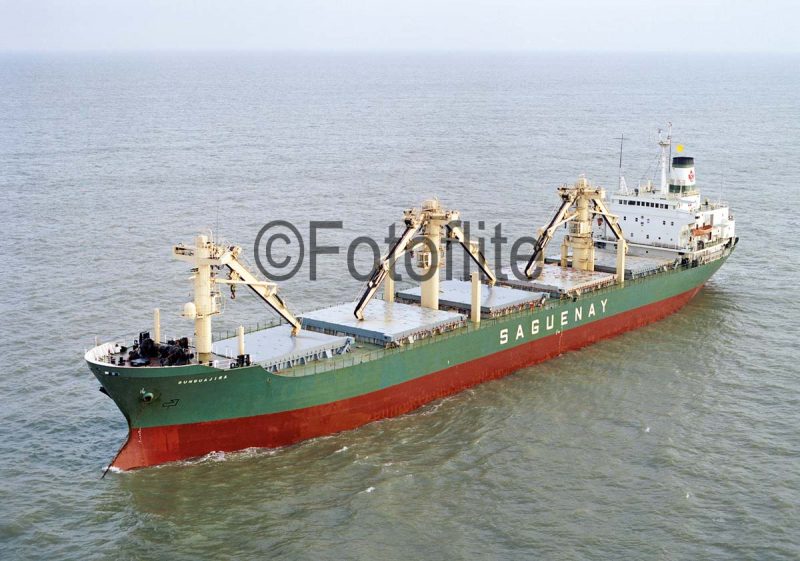
Coke and coal was also imported at Blyth for Lynemouth Power Station from Louisiana after the local sources ran out altogether. Two alumina trains per day each consisting of 21 wagons ran from Blyth to Lynemouth, with other freight trains running across Scotland to the Fort William smelter of Alcan. The Lynemouth smelter had two of the most efficient ring burners in the world, each costing £17 million, and it was the only smelter in Europe which could rebuild the burners during a one hundred day process while production continued apace. This process took place every seven years, but as soon as the last aluminium was produced on 29th March 2012, the burners ‘congealed’ and were totally useless for further production. The eight tall chimneys of the smelter were demolished in June 2016, with the electricity of the 420 megawatt Lynemouth Power Station switched to the National Grid. Lynemouth Power Station switched from burning coal to biomass from Vancouver at the end of 2017 under new ownership. The Lochaber smelter at Fort William powered by hydro electricity from the Ben Nevis area is still in production after an investment of £120 million at the Rio Tinto Alcan plant after its 2017 takeover by Liberty House and Simec. The alumina arrives by train at the plant after being refined at Aughinish and shipped to Scotland.
Postscript
The green hulled Saguenay Terminals vessels with black funnels with a central aluminium colour painted band fringed with two thin green bands and a green ‘S’ on the aluminium painted band were easily identified, especially if there were flying the similar green and white pennant. The fleet flourished in post-war years with an enormous number of bareboat and time chartered vessels, running into hundreds, but quickly ended in the 1980s as the parent company of Alcan moved to single voyage charters for transport of raw materials and finished products to and from its worldwide aluminium smelters, and alumina and bauxite plants. The green hulls were usually painted up with big letters of ‘SAGUENAY TERMINALS’ in white, while the letters were in green on light grey hulls. The big Canadian fleet had a shrewd mastermind to lead it in the shape of the Vice President and General Manager, F. Leslie Parsons.
Alcan did build a trio of bulkers in 1989 at the Nippon Kokan K. K. yard in Japan for registration under its own name, these were the sisters Northern Progress and Northern Venture of 36,445 dwt, and the larger bulker Northern Enterprise of 66,995 dwt. The smaller sisters carried alumina from Port Esquivel in Jamaica to Port Alfred on the Saguenay, while the bigger bulker ventured further afield for her cargoes of alumina. Alcan sold the trio in 2001, with the two sisters sold to Federal Navigation of Canada and renamed Federal Progress and Federal Venture, while the bigger bulker was sold to Cobelfret of Belgium and renamed Lowlands Saguenay.
The very large time chartered Saguenay Terminals fleet was largely dictated by the blocking by ice of the St. Lawrence for four or five months as well as fluctuations in the demand for aluminium. This practice is very widespread today, with a very small number of owned or long bareboat chartered vessels, and a huge fleet of short time chartered vessels as shipowners and shippers try to juggle big variations in demand and supply. The handling of cargoes of alumina was another big problem, as on very windy days the fine white powder tended to end up all over the deck of the ship and the nearby quaysides rather than in the silo.

The memories of these very fine cargo-liners and bulkers of the Saguenay Terminals fleet are still very strong, and we are grateful to having seen them in the U.K. on their very interesting triangular route to the Caribbean.
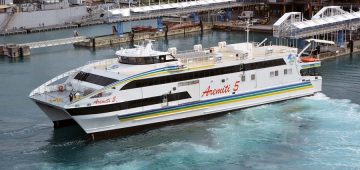



Comments
Sorry, comments are closed for this item